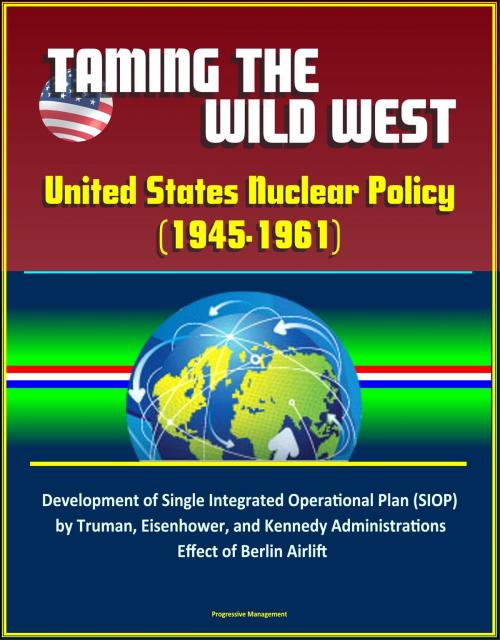Taming the Wild West: United States Nuclear Policy (1945-1961) - Development of Single Integrated Operational Plan (SIOP) by Truman, Eisenhower, and Kennedy Administrations, Effect of Berlin Airlift
Nonfiction, History, Military, Nuclear Warfare, Americas, United States, 20th Century| Author: | Progressive Management | ISBN: | 9781370061808 |
| Publisher: | Progressive Management | Publication: | January 22, 2017 |
| Imprint: | Smashwords Edition | Language: | English |
| Author: | Progressive Management |
| ISBN: | 9781370061808 |
| Publisher: | Progressive Management |
| Publication: | January 22, 2017 |
| Imprint: | Smashwords Edition |
| Language: | English |
This excellent report has been professionally converted for accurate flowing-text e-book format reproduction. While the United States adopted several national policies regulating nuclear weapons during the late 1940s and 1950s, it would take until 1961 for the United States to have a cohesive operational plan for the employment of nuclear weapons. This was known as the Single Integrated Operational Plan (SIOP). Prior to the SIOP, combatant commanders independently developed theater nuclear war plans, leading to uncoordinated, redundant, and overlapping nuclear strikes. These independently formed plans led to a state of chaos much like the American wild west. When President Eisenhower directed creation of the first SIOP, known as SIOP-62, it revolutionized nuclear war planning and effectively tamed the wild west. The SIOP integrated the various military service plans and created a master plan for the nation in time of nuclear war eliminating much of the chaos caused by lack of coordination. Studying the period 1945-1961 provides nuclear planners and policy makers with the perspective needed to understand why current United States policies exist.
Since 1945, America has relied on nuclear weapons as the last line of defense and primary deterrent preventing communist aggression. The SIOP, therefore, is the ultimate protection plan against total war. However, did SIOP-62 make the world a safer place? Yes, it did; but the true value of SIOP-62 was not formation of the perfect plan. Instead, SIOP-62, codified a planning process that created a standard for all future war plans. The study of policy in this paper focuses on the events and people that shaped United States nuclear policy and formed the first SIOP.
CHAPTER 1 - INTRODUCTION * Thesis Statement * Methodology * Notable Works * Contributors to Nuclear Strategy * Key Terms * Conclusion * CHAPTER 2 - THE TRUMAN ADMINISTRATION'S INFLUENCE ON THE SIOP (1945-1952) * Introduction * Truman Takes Office * International Control * Containment * National Security Act of 1947 * Fiscal Year 1950 Budget Battle * Strategic Air Command * War Plans * The Berlin Airlift * NSC-30 * NSC-68 * Korean War * Conclusion * CHAPTER 3 - THE EISENHOWER ADMINISTRATION'S INFLUENCE ON THE SIOP (1953-1960) * Introduction * Eisenhower Takes Office * Korean War * NSC-162/2 * Killian Report * Gaither Report * Hickey Report * Eisenhower Orders SIOP * SIOP Development * Conclusion * CHAPTER 4 - THE KENNEDY ADMINISTRATION'S ASSESSMENT OF THE SIOP (1961) * Introduction * Kennedy Takes Office * First Exposure to SIOP-62 * McNamara Orders Changes * Bay of Pigs * Kennedy Meets with Khrushchev * Return to Nuclear Testing * SIOP-62 Briefing to Kennedy * SIOP Background * SIOP Strategy * SIOP Forces * SIOP Options * SIOP Flexibility * Show of Force * Conclusion * CHAPTER 5 - CONCLUSIONS * President Truman * President Eisenhower * Conclusion * Recommendation
This excellent report has been professionally converted for accurate flowing-text e-book format reproduction. While the United States adopted several national policies regulating nuclear weapons during the late 1940s and 1950s, it would take until 1961 for the United States to have a cohesive operational plan for the employment of nuclear weapons. This was known as the Single Integrated Operational Plan (SIOP). Prior to the SIOP, combatant commanders independently developed theater nuclear war plans, leading to uncoordinated, redundant, and overlapping nuclear strikes. These independently formed plans led to a state of chaos much like the American wild west. When President Eisenhower directed creation of the first SIOP, known as SIOP-62, it revolutionized nuclear war planning and effectively tamed the wild west. The SIOP integrated the various military service plans and created a master plan for the nation in time of nuclear war eliminating much of the chaos caused by lack of coordination. Studying the period 1945-1961 provides nuclear planners and policy makers with the perspective needed to understand why current United States policies exist.
Since 1945, America has relied on nuclear weapons as the last line of defense and primary deterrent preventing communist aggression. The SIOP, therefore, is the ultimate protection plan against total war. However, did SIOP-62 make the world a safer place? Yes, it did; but the true value of SIOP-62 was not formation of the perfect plan. Instead, SIOP-62, codified a planning process that created a standard for all future war plans. The study of policy in this paper focuses on the events and people that shaped United States nuclear policy and formed the first SIOP.
CHAPTER 1 - INTRODUCTION * Thesis Statement * Methodology * Notable Works * Contributors to Nuclear Strategy * Key Terms * Conclusion * CHAPTER 2 - THE TRUMAN ADMINISTRATION'S INFLUENCE ON THE SIOP (1945-1952) * Introduction * Truman Takes Office * International Control * Containment * National Security Act of 1947 * Fiscal Year 1950 Budget Battle * Strategic Air Command * War Plans * The Berlin Airlift * NSC-30 * NSC-68 * Korean War * Conclusion * CHAPTER 3 - THE EISENHOWER ADMINISTRATION'S INFLUENCE ON THE SIOP (1953-1960) * Introduction * Eisenhower Takes Office * Korean War * NSC-162/2 * Killian Report * Gaither Report * Hickey Report * Eisenhower Orders SIOP * SIOP Development * Conclusion * CHAPTER 4 - THE KENNEDY ADMINISTRATION'S ASSESSMENT OF THE SIOP (1961) * Introduction * Kennedy Takes Office * First Exposure to SIOP-62 * McNamara Orders Changes * Bay of Pigs * Kennedy Meets with Khrushchev * Return to Nuclear Testing * SIOP-62 Briefing to Kennedy * SIOP Background * SIOP Strategy * SIOP Forces * SIOP Options * SIOP Flexibility * Show of Force * Conclusion * CHAPTER 5 - CONCLUSIONS * President Truman * President Eisenhower * Conclusion * Recommendation















